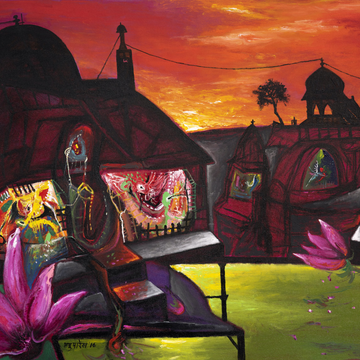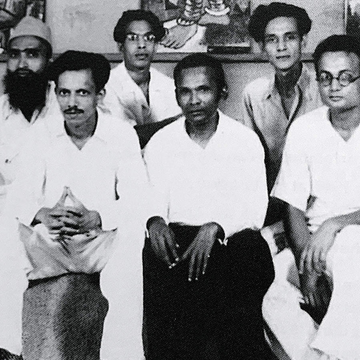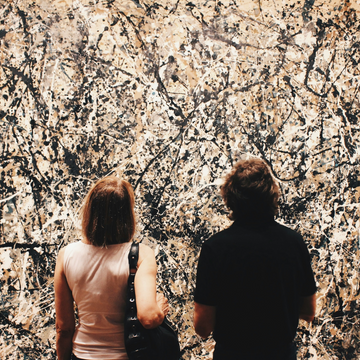A 10-step Guide to Understanding the Value of Art

Whether you own a piece of art or are planning to buy one, determination of the value of a piece of art is of utmost importance and is at the core of all art transactions.
Whether you own a piece of art or are planning to buy one, determination of the value of a piece of art is of utmost importance and is at the core of all art transactions. This valuation of art can be a daunting process for even the best art galleries, auction houses or the most knowledgeable art collectors over the world. However, there are certain criteria that specialists all over the world consider while diving into the challenges of art valuation. These parameters help reduce the inherent ambiguity in art assessment and try to base the process on a strong foundation of logical and scientific reasoning.
Here at Eikowa, we understand the importance of determining and delivering the true value of art to our customers and ensure that the value is sustained along the chain, when a piece of art changes hands. Our Art Advisory Program, designed to assist you to discover the perfect piece of art and make the right decision at each step of the art buying process, incorporates the following top 10 parameters that are considered in order to achieve this aim:
1. Authenticity

Authenticity is the originality of the piece of art, a verification of its genuineness in the most basic way. It is about separating a fake or a copy from an original and then defining whether anything has been altered or reworked since the time of its creation.
The determination of authenticity requires a piece of art to correspond to all the typical elements displayed by its particular category, for example the materials of the painting are inspected to see if the paper is appropriate of the period in which it was supposed to be created, if the characteristics of the canvas conform to those available at that time, if the features of the painting are typical of that particular artist, the way a human figure is always painted, or the minute details of specific highlights of body parts every time.
2. Condition

Condition is the physical state of the preservation of art; its life, from the day it was created, revealed in the present. There is a widespread misconception that anything old ought to show signs of age. In fact, the most valuable objects of art age really well, adhering to their original state just like the day they were when they left the artist’s studio.
Having said that, we also need to accept that ageing is inevitable. The surface of oil in oil paintings can contract and shrink over time after enduring multiple weather cycles from the extremes of hot to cold temperatures. This causes cracking. Restorations in such cases are pretty standard depending upon the type of art. If restoration is required, it is usually left up to the collector to decide how much of it he desires.
In oil paintings, if there is cracking to the extent that it has caused paint loss and that paint loss has been filled with a conservator having to retouch the work, then that can result in a devaluation. But traditionally, a painting being dirty has been an exciting thing, as it means that it has been off the market for a long time.
Eikowa’s Art Maintenance Program helps customers maintain their valuable assets in art to ensure that their value is preserved over time.
3. Rarity

Rarity is a major determinant of the value of art. As the natural chances of any piece of art having survived all through these centuries, not lost in obscurity, damaged or destroyed are pretty slim due to sheer probability, rarity is directly linked to desirability. This desirability can translate into a valuation of art with no upper limit.
As the supply and demand dynamics in the art market understand rarity, the prices increase exponentially because an artist may have made only a few paintings throughout his career for which there is great demand. For example, the paintings of Vasudeo S. Gaitonde sold at a record price at a Christie’s auction which created high demand for his other paintings too. Eventually, paintings from his birthplace at Nagpur, lying in a warehouse were sent for restoration and then sold at an auction since he created only a limited number of paintings throughout his life.
Even shortcomings in the condition can be forgiven if the object of art is rare enough. The older things are, the rarer they become and the more difficult it is to get them in satisfactory condition. How hard it is to find a painting is directly linked to the sense of accomplishment and pride associated with owning it, which in turn makes it difficult to put a price on desirability.
4. Provenance

The histories of ownership of a piece of art make for some of the most intriguing stories ever. For whom was the piece made, how many different owners it passed through during its lifetime, what significance it had in the lives of its owners, all these questions help to create an interest in the art market.
The longer that something has been off the market, has stayed in the family of the artist, never changing hands, never having been transacted until the present, the greater is the value attached to it. The buyer of such a piece is not just getting the physical piece of art but is becoming a part of its history, which might be as interesting —if note more— as the life of the artist who made it.
5. Subject Matter

The subject matter is at the core of the existence of the painting, its soul bestowing it with life. Certain subjects have proven to be consistently admired throughout history, such as nudes, bright landscapes, etc. Portraits are always popular as they are easy images that one can relate to at a glance. Similarly, female forms have historically sold better and are usually more attractive than the male forms.
Contemporary art, with its beginning in the abstract expressionism, relating to the painting itself, its structure and interaction with the object, is an area where subject matter is relatively difficult to understand and may not be palatable to all, but greatly desired by some. Such art has the capacity to challenge traditional subject matter. Hence, it is not always the easy subjects that sell the best. Challenging compositions can be even more attractive.
6. Historical importance

The historical importance of art is derived from the day it was created, the circumstances of its birth, and the wider historical context that it was a part of. There have been paintings created by artists in the years post the Indian Independence when times were uncertain around them, economic crises had crippled the nation and various other political and social issues ravaged normal life. The themes of these paintings are tinged by the imagery that the artists linked to their surroundings and environment at that time.
The thought of owning a piece of art that has witnessed the Indian Independence or survived through the Partition, having played a role in the development of world history, as we know it today, is invaluable. Those decisive moments in time that can never be captured again, result in a major increase in the value of art created in those eras.
7. Medium

Medium is the foundation of art, playing a great role in its valuation too. There tends to be an unwritten hierarchy of media in the art world. For example, in paintings, oil on canvas is the most desirable media, followed by acrylics on canvas. Nowadays, a mixture of oil and acrylics is also being used. In sculptures, marble is at the top, followed by bronze and then plaster.
Apart from the visual appeal, which is rooted in the medium, there are a number of practical aspects depending upon the medium too. The durability and longevity of paintings are derived from the media in which they are created. From an artist’s point of view, some subjects might be rendered more intensely in some specific media than others, which eventually becomes a great determinant of the value of art.
8. Size

The size of art is inextricably linked with the other inherent attributes of that piece of art. It definitely matters, but not necessarily in the way one might think. In some categories of art, minute objects can be highly valued, for example, in a sale of Chinese works of art, the most expensive pieces are generally small, but in a category like Post Independence painting, larger works can be highly desirable. The themes of some paintings are such that they require a greater space for proper portrayal. So, they naturally tend to be more valuable.
A modern-day need for statement pieces, such as larger paintings adorning a huge wall, can result in the bigger being better. But that is not always the case. In portraits, small figureheads can be of a higher value than larger pictures, depending upon what is being expressed and how it is being depicted.
9. Series of Paintings

An artist, over the course of his life, creates various series of paintings. Some are more popular than the others, especially the ones made during the zenith of the artist’s career. These series that do exceptionally well and the ones that follow it, after the artist has made a great impact in the art world, are more likely to be of greater value.
The differences in the value of paintings depending upon the series that they belong to also follows from the natural progression of the artist due to an increase in skill, craftsmanship, the expression of deeper subjects, innovation on the medium, etc. over the course of his life. The demand for some series of paintings is more than others, which also results in the paintings belonging to that series being valued more than the other paintings from the same artist.
10. Trends

Trends in art are steeped in ambiguity, but at the same time, affect the value of art to a great extent. Trends seem to be cyclical in nature; they arrive and leave, only to come back again. They are important and need to be tracked carefully in order to be relevant in the market. For example, today, people prefer large, bold, colourful works when it comes to paintings over still life or pictures of animals.
Trends keep on changing, and prices of paintings reflect that. However, longevity and consistency also have their sound place in the market, with some timeless pieces being immune to the fluctuations of fashion trends owing to their intrinsic magnificence and classic relevance.
The above criteria, along with our 10-step Beginner’s Guide to Investing in Art, equip a buyer with all the tools necessary to understand the value of art from its very roots and make an informed decision while investing in it. Eikowa delivers such peace of mind for all its customers by indulging in depth in each of the above parameters and many more to ensure that every art transaction is executed to the maximum benefit of all its stakeholders.








